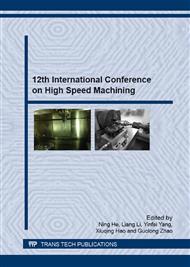p.250
p.256
p.263
p.270
p.277
p.283
p.290
p.296
p.304
Tool Material Selection Based on Analytic Hierarchy Process Method in Machining Al-Si Piston Alloy
Abstract:
Cutting tool is the executor and core element of machining, and tool material is of decisive significance for the development of high-speed machining technology. For a particular workpiece material, to select the appropriate tool material is an important prerequisite to increase the machining productivity and to improve the machined surface quality.In this paper, a weighting method of subjective judgment was utilized to conduct criteria weighting in the tool materials selection when machining Al-Si piston alloy. The analytic hierarchy process (AHP) method was used to subjectively judge the significance of the material properties and determine their criteria weight. The hierarchical structure model, with the objective layer, the criterion layer, and the alternative layer, was established. The performance of tool materials was set as the objective layer. Seven property indexes, such as density, Young's modulus, hardness, fracture toughness, thermal stability, thermal conductivity, thermal expansion coefficient, were chosen as the criterion layer in comparative judgment of the alternatives and criteria. And five kinds of tool materials, YG6X Cemented carbide, YG8 Cemented carbide, PCD, CBN, and Ceramic were chosen as the alternative layer. Then the pairwise comparison matrix of the material property index was constructed to compare a set of criteria pairwise according to their relative importance weight. The comparative weights were derived by finding the largest eigenvector with respective of the matrix. Finally, the consistency index and consistency ratio were calculated to ensure the consistency of the subjective perception and the accuracy of comparative weights. Then the weights of the material properties were determined, and the synthesis scores of the different tool material candidates were obtained.Results revealed that PCD was found as best materials for Al-Si piston alloy machining, and YG8 is slightly more suitable than YG6X for machining Al-Si piston alloy. In short, the qualitative problems in tool material selection were realized systematically and hierarchically by quantitatively calculation and analysis. This provides a new thinking in tool materials selection for high efficiency machining of difficult-to-machine materials.
Info:
Periodical:
Pages:
277-282
Citation:
Online since:
January 2016
Authors:
Price:
Сopyright:
© 2016 Trans Tech Publications Ltd. All Rights Reserved
Share:
Citation:


